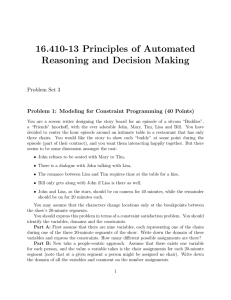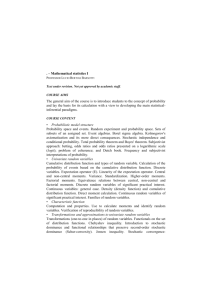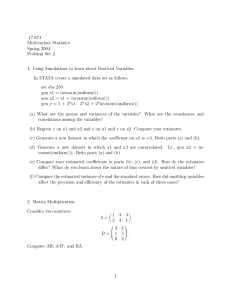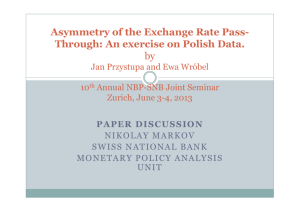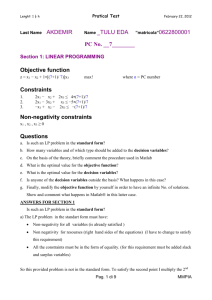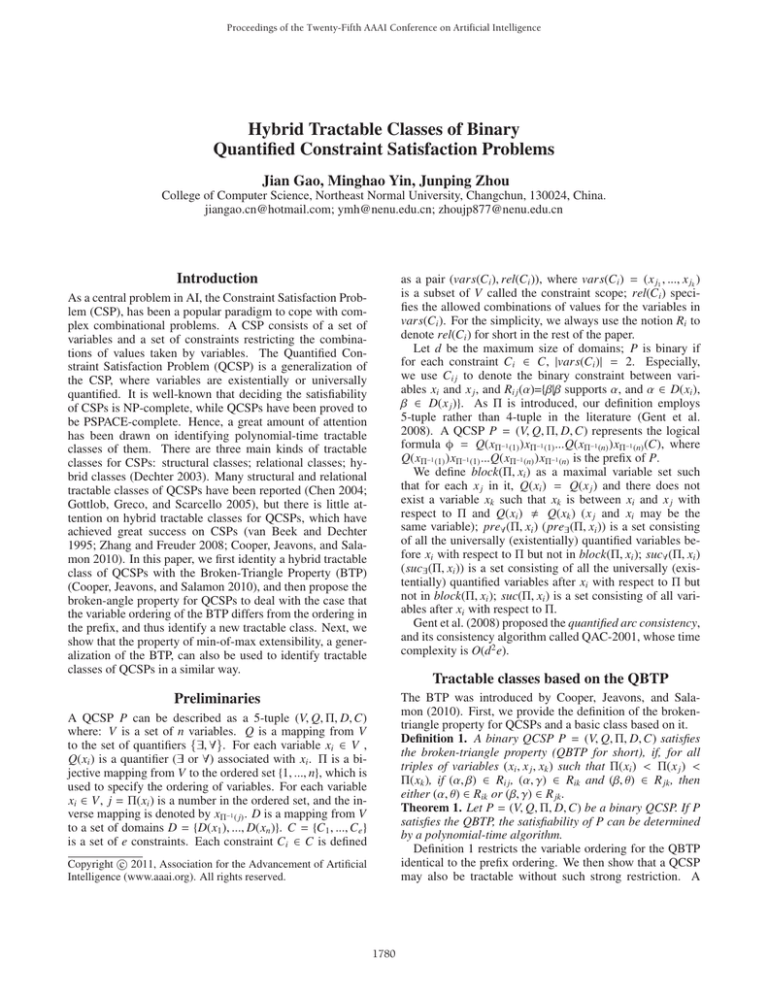
Proceedings of the Twenty-Fifth AAAI Conference on Artificial Intelligence
Hybrid Tractable Classes of Binary
Quantified Constraint Satisfaction Problems
Jian Gao, Minghao Yin, Junping Zhou
College of Computer Science, Northeast Normal University, Changchun, 130024, China.
jiangao.cn@hotmail.com; ymh@nenu.edu.cn; zhoujp877@nenu.edu.cn
as a pair (vars(Ci ), rel(Ci )), where vars(Ci ) = (x j1 , ..., x jk )
is a subset of V called the constraint scope; rel(Ci ) specifies the allowed combinations of values for the variables in
vars(Ci ). For the simplicity, we always use the notion Ri to
denote rel(Ci ) for short in the rest of the paper.
Let d be the maximum size of domains; P is binary if
for each constraint Ci ∈ C, |vars(Ci )| = 2. Especially,
we use Ci j to denote the binary constraint between variables xi and x j , and Ri j (α)={β|β supports α, and α ∈ D(xi ),
β ∈ D(x j )}. As Π is introduced, our definition employs
5-tuple rather than 4-tuple in the literature (Gent et al.
2008). A QCSP P = (V, Q, Π, D, C) represents the logical
formula φ = Q(xΠ−1 (1) )xΠ−1 (1) ...Q(xΠ−1 (n) )xΠ−1 (n) (C), where
Q(xΠ−1 (1) )xΠ−1 (1) ...Q(xΠ−1 (n) )xΠ−1 (n) is the prefix of P.
We define block(Π, xi ) as a maximal variable set such
that for each x j in it, Q(xi ) = Q(x j ) and there does not
exist a variable xk such that xk is between xi and x j with
respect to Π and Q(xi ) Q(xk ) (x j and xi may be the
same variable); pre∀ (Π, xi ) (pre∃ (Π, xi )) is a set consisting
of all the universally (existentially) quantified variables before xi with respect to Π but not in block(Π, xi ); suc∀ (Π, xi )
(suc∃ (Π, xi )) is a set consisting of all the universally (existentially) quantified variables after xi with respect to Π but
not in block(Π, xi ); suc(Π, xi ) is a set consisting of all variables after xi with respect to Π.
Gent et al. (2008) proposed the quantified arc consistency,
and its consistency algorithm called QAC-2001, whose time
complexity is O(d2 e).
Introduction
As a central problem in AI, the Constraint Satisfaction Problem (CSP), has been a popular paradigm to cope with complex combinational problems. A CSP consists of a set of
variables and a set of constraints restricting the combinations of values taken by variables. The Quantified Constraint Satisfaction Problem (QCSP) is a generalization of
the CSP, where variables are existentially or universally
quantified. It is well-known that deciding the satisfiability
of CSPs is NP-complete, while QCSPs have been proved to
be PSPACE-complete. Hence, a great amount of attention
has been drawn on identifying polynomial-time tractable
classes of them. There are three main kinds of tractable
classes for CSPs: structural classes; relational classes; hybrid classes (Dechter 2003). Many structural and relational
tractable classes of QCSPs have been reported (Chen 2004;
Gottlob, Greco, and Scarcello 2005), but there is little attention on hybrid tractable classes for QCSPs, which have
achieved great success on CSPs (van Beek and Dechter
1995; Zhang and Freuder 2008; Cooper, Jeavons, and Salamon 2010). In this paper, we first identity a hybrid tractable
class of QCSPs with the Broken-Triangle Property (BTP)
(Cooper, Jeavons, and Salamon 2010), and then propose the
broken-angle property for QCSPs to deal with the case that
the variable ordering of the BTP differs from the ordering in
the prefix, and thus identify a new tractable class. Next, we
show that the property of min-of-max extensibility, a generalization of the BTP, can also be used to identify tractable
classes of QCSPs in a similar way.
Tractable classes based on the QBTP
The BTP was introduced by Cooper, Jeavons, and Salamon (2010). First, we provide the definition of the brokentriangle property for QCSPs and a basic class based on it.
Definition 1. A binary QCSP P = (V, Q, Π, D, C) satisfies
the broken-triangle property (QBTP for short), if, for all
triples of variables (xi , x j , xk ) such that Π(xi ) < Π(x j ) <
Π(xk ), if (α, β) ∈ Ri j , (α, γ) ∈ Rik and (β, θ) ∈ R jk , then
either (α, θ) ∈ Rik or (β, γ) ∈ R jk .
Theorem 1. Let P = (V, Q, Π, D, C) be a binary QCSP. If P
satisfies the QBTP, the satisfiability of P can be determined
by a polynomial-time algorithm.
Definition 1 restricts the variable ordering for the QBTP
identical to the prefix ordering. We then show that a QCSP
may also be tractable without such strong restriction. A
Preliminaries
A QCSP P can be described as a 5-tuple (V, Q, Π, D, C)
where: V is a set of n variables. Q is a mapping from V
to the set of quantifiers {∃, ∀}. For each variable xi ∈ V ,
Q(xi ) is a quantifier (∃ or ∀) associated with xi . Π is a bijective mapping from V to the ordered set {1, ..., n}, which is
used to specify the ordering of variables. For each variable
xi ∈ V, j = Π(xi ) is a number in the ordered set, and the inverse mapping is denoted by xΠ−1 ( j) . D is a mapping from V
to a set of domains D = {D(x1 ), ..., D(xn )}. C = {C1 , ..., Ce }
is a set of e constraints. Each constraint Ci ∈ C is defined
c 2011, Association for the Advancement of Artificial
Copyright Intelligence (www.aaai.org). All rights reserved.
1780
(Cooper, Jeavons, and Salamon 2010). In this section, we
introduce the definition of MME for QCSPs.
Definition 5. Let PΠ = (V, Q, Π, D, C) be a binary QCSP,
where all variable domains are totally ordered. It is minof-max extendable (QMME for short), if for all triples of
variables (xi , x j , xk ) such that Π(xi ) < Π(x j ) < Π(xk ), if
(α, β) ∈ Ri j , then assignments (< xi , α >, < x j , β >, < xk , γ >
) are consistent; a triple of variables (xi ,x j ,xk ) is extended
QMME under the QCSP PΠ if Π(xi ) ≤ Π(x j ) < Π(xk ), and
for each pair of (α, β) such that α ∈ D(xi ) and β ∈ D(x j ),
assignments (< xi , α >, < x j , β >, < xk , γ >) are consistent ,
where γ = min(max(Rik (α), max(R jk (β)).
Theorem 5. Let PΠ = (V, Q, Π, D, C) be a binary quantified
arc consistent QCSP whose variable domains are totally ordered. PΠ is satisfiable if there exists a mapping Δ such that:
1. Π is semi-compatible with Δ;
2. PΔ = (V, Q, Δ, D, C) is QMME;
3. For each existentially quantified xk , for each pair of
variables (xi , x j ) such that xi , x j ∈ di f (Π, Δ, xk ) and Δ(xi ) ≤
Δ(x j ), (xi , x j , xk ) is extended QMME under PΔ .
In this paper, we have concentrated on identifying
tractable classes of QCSPs by using hybrid techniques, such
as the broken-triangle property and min-of-max extendability. We omit the proofs of them due to limitations of space.
For more details, we refer to (Gao, Yin, and Zhou 2011).
tractable class allowing variables can shift in their own
blocks is described as follows.
Definition 2. Let PΠ = (V, Q, Π, D, C) and PΔ =
(V, Q, Δ, D, C) be binary QCSPs. Π is block-compatible with
Δ if they satisfy the following conditions:
1. For each existentially quantified variable xi ∈ V,
pre∀ (Π, xi ) = pre∀ (Δ, xi );
2. For each pair of universally quantified variables
(xi , x j ), if Π(xi ) < Π(x j ), then Δ(xi ) < Δ(x j ).
In Definition 2, we only consider the ordering of existentially quantified variables, because constraints between universally quantified variables make no effect on the QBTP.
Theorem 2. Given a binary QCSP PΠ = (V, Q, Π, D, C), the
satisfiability of PΠ can be determined by a polynomial-time
algorithm if there exists a mapping Δ such that:
1. Π is block-compatible with Δ;
2. PΔ = (V, Q, Δ, D, C) satisfies the QBTP.
Next, we discuss the case that existentially variables can
shift between blocks. Shifting existentially quantified variables in front of universally quantified variables is trivial.
We only need to consider the case that shifting existentially
quantified variables after universally quantified variables.
Definition 3. Let PΠ = (V, Q, Π, D, C) and PΔ =
(V, Q, Δ, D, C) be binary QCSPs, Π is semi-compatible with
Δ if they satisfy the following conditions:
1. For each existentially quantified variable xi ∈ V,
pre∀ (Π, xi ) ⊆ pre∀ (Δ, xi );
2. For each pair of universally quantified variables
(xi , x j ), if Π(xi ) < Π(x j ), then Δ(xi ) < Δ(x j ).
To identify a new tractable class under semi-compatible
orderings, we have to introduce the broken-angle property
for QCSPs.
Definition 4. A triple of variables (xi ,x j ,xk ) satisfies
the broken-angle property under a binary QCSP PΠ =
(V, Q, Π, D, C) (QBAP for short) if :
1. Π(xi ) ≤ Π(x j ) < Π(xk );
2. For each pair of (α, β) (α ∈ D(xi ), β ∈ D(x j )), if (α, γ) ∈
Rik and (β, θ) ∈ R jk , then either (α, θ) ∈ Rik or (β, γ) ∈ R jk .
Acknowledgements
This work was supported by the National Natural Science
Foundation of China Granted No. 60803102 and 60973033.
References
Chen, H. 2004. Collapsibility and consistency in quantified
constraint satisfaction. In Proc. AAAI’04, 155–160. AAAI
Press / The MIT Press.
Cooper, M. C.; Jeavons, P. G.; and Salamon, A. Z.
2010. Generalizing constraint satisfaction on trees: Hybrid tractability and variable elimination. Artif. Intell. 174(910):570–584.
Dechter, R. 2003. Constraint Processing. Morgan Kaufmann.
Gao, J.; Yin, M.; and Zhou, J. 2011. Hybrid tractable classes
of binary quantified constraint satisfaction problems. Technical Report 1–8.
Gent, I. P.; Nightingale, P.; Rowley, A.; and Stergiou, K.
2008. Solving quantified constraint satisfaction problems.
Artif. Intell. 172:738–771.
Gottlob, G.; Greco, G.; and Scarcello, F. 2005. The complexity of quantified constraint satisfaction problems under
structural restrictions. In Proc. IJCAI’05, 150–155. Professional Book Center.
van Beek, P., and Dechter, R. 1995. On the minimality
and global consistency of row-convex constraint networks.
Journal of the ACM 42:543–561.
Zhang, Y., and Freuder, E. C. 2008. Properties of tree convex
constraints. Artif. Intell. 172:1605–1612.
Theorem 3. Given a binary QCSP PΠ = (V, Q, Π, D, C) that
is quantified arc consistent, PΠ is satisfiable if there exists a
mapping Δ such that:
1. Π is semi-compatible with Δ;
2. PΔ = (V, Q, Δ, D, C) satisfies the QBTP;
3. For each existentially quantified variable xk , for each
pair of variables (xi , x j ) such that xi , x j ∈ di f (Π, Δ, xk ) and
Δ(xi ) ≤ Δ(x j ), the triple (xi , x j , xk ) satisfies the QBAP under
PΔ , where di f (Π, Δ, xk ) = suc∃ (Π, xk ) − suc(Δ, xk ).
Such PΔ is called a QBTP-adjoint problem of PΠ . Such Δ
can be found in polynomial time.
Theorem 4. Given a binary QCSP PΠ = (V, Q, Π, D, C),
there exists a polynomial-time algorithm to find a mapping
Δ such that PΔ = (V, Q, Δ, D, C) is a QBTP-adjoint problem
of PΠ . (or determine that no such mapping exists.)
The Min-of-max Extendable Class
The min-of-max extendable (MME) class can be regarded as
a generalization of the class with the BTP in classical CSPs
1781

